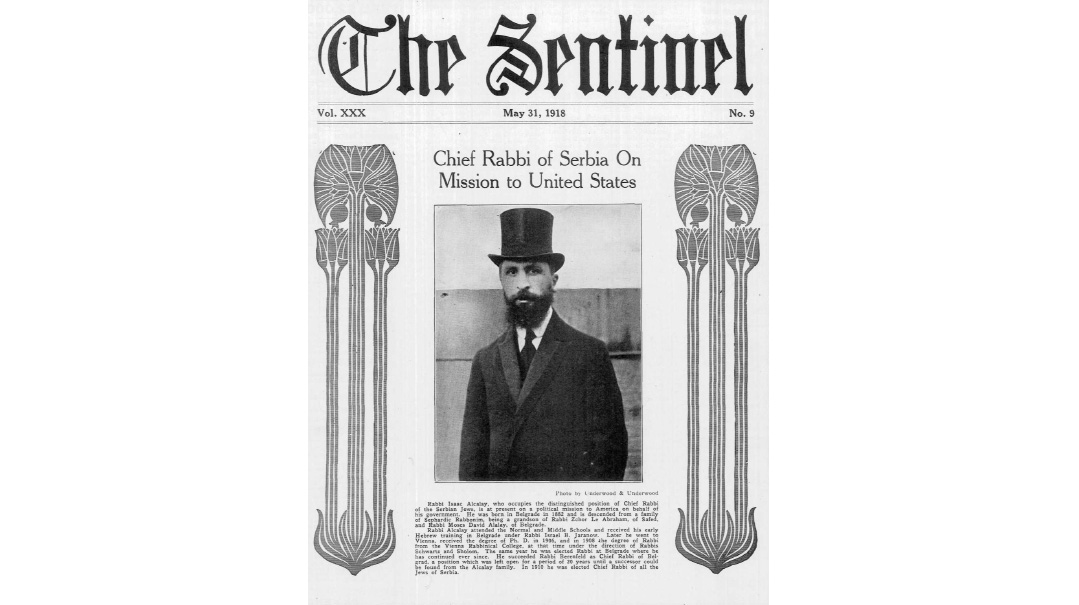Only Simchahs
| April 11, 2022A sampling of happy life-cycle events involving recent historical figures. So sit back and enjoy the simchah! L’chayim!

Beginning in the mid-19th century, newspapers had a transformative effect on Eastern European Jewish life. Periodicals such as Ha-Melitz, Ha-Tsfira, Der Moment, and Haynt disseminated information in a way never before seen among the Jewish masses. Ha-Levanon, Hamodia, Dos Vort, and Yiddishes Tageblatt soon joined the crowded newsstands, competing with secular journals to set the agenda for public discourse.
While these outlets circulated news from Jewish communities near and far, debating the hot topics of the day such as emancipation, nationalism, anti-Semitism, economic struggles, and religious issues, they also served as a forum for sharing lighter aspects of Jewish life.
One innovative medium that gained popularity in the early 20th century was the simchah announcement. Joyful reports that were previously limited to the province of communal grapevines could now be splashed on the pages of one’s favorite newspaper, allowing friends and family far and wide to share the celebratory news. The trend spread to Israel and America as the religious population in those countries grew.
What follows is a sampling of happy life-cycle events involving recent historical figures. So sit back and enjoy the simchah! L’chayim!
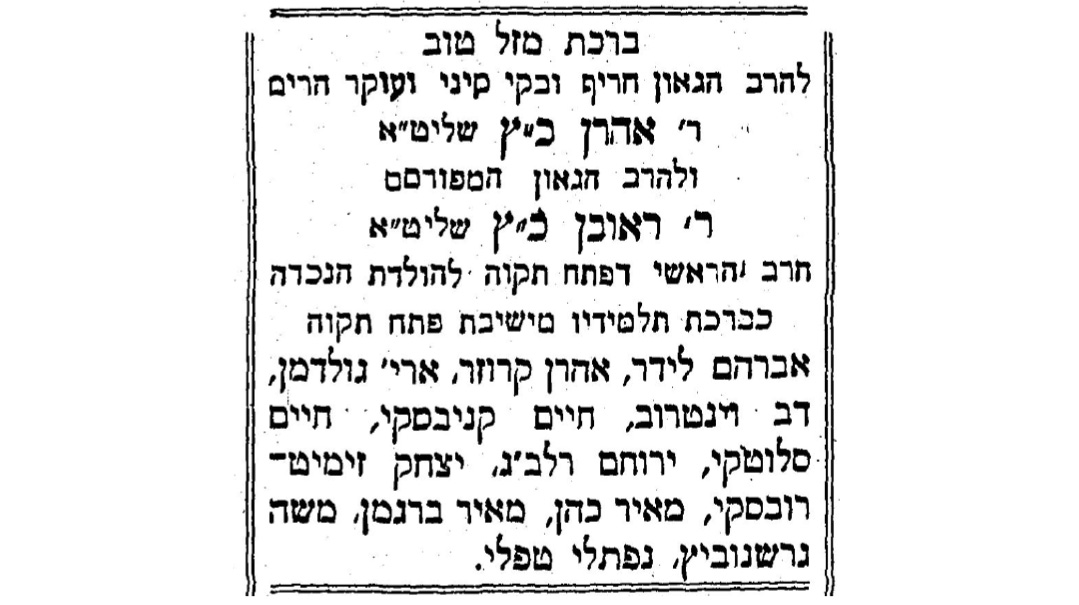
Rav Aharon Katz and Chana Rasha Witkind (1945)
When Rav Aharon Katz, son of Rav Reuven Katz (Petach Tikvah’s chief rabbi and author of Degel Reuven), celebrated the birth of a child, it was only natural that this rebbi at the Lomza Yeshivah be feted with a mazel tov ad from his talmidim. Among the students named were 17-year-old Chaim Kanievsky and 15-year-old Meir Tzvi Bergman. Rebbetzin Chana Rasha was the daughter of Rav Meir Shmuel Witkind, whose brother Rav Hillel Witkind was one of the closest talmidim of the Alter of Novardok and the founder of the first Novardok yeshivah in the Holy Land in Tel Aviv in 1929.
Rav Aharon Katz studied in Grodno as a student of Rav Shimon Shkop, followed by many years in Mir. Following his marriage in 1939, he and his young bride moved to Palestine just as the war commenced in Europe. Rav Meir Shmuel Witkind and his family fell victim to the Nazis. Upon arriving in Eretz Yisrael, Rav Aharon joined his father in Petach Tikvah, eventually emerging as the rosh yeshivah of Lomza. In his later years, he served as a dayan with the Jerusalem Rabbanut. When he was niftar shortly before the onset of Shavuos in 1997, he was eulogized by his old friend from the Mir, Rav Chaim Pinchas Scheinberg, who mourned the loss of this tzaddik and lamdan.
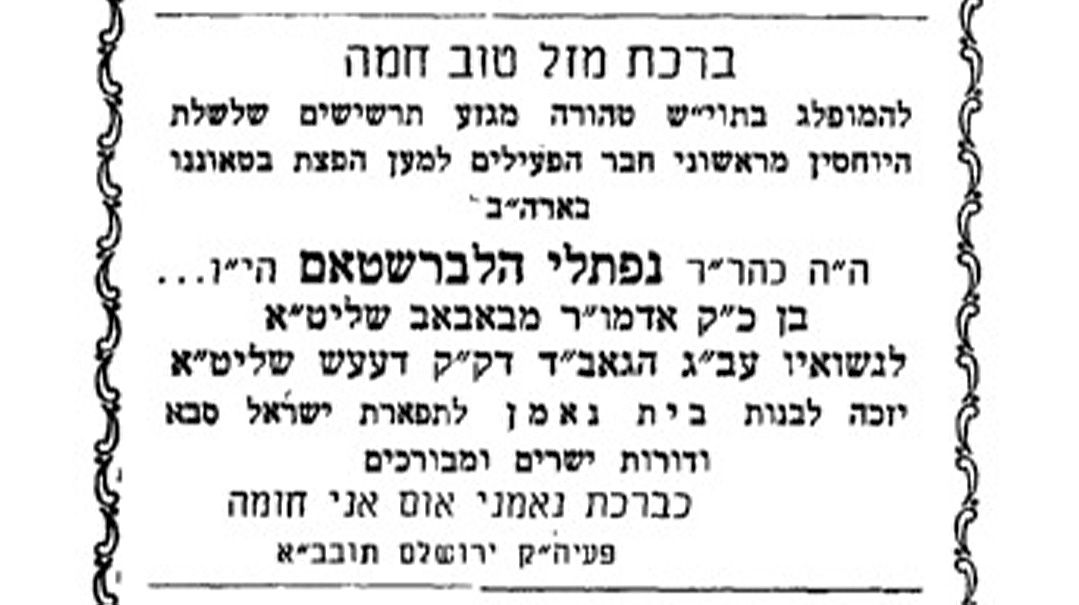
Rav Naftali Halberstam and Hesa Paneth (1951)
After miraculously surviving the war with his father, Rav Shlomo Halberstam of Bobov, Naftali was sent to Yerushalayim to study, later rejoining his father in New York. His Yerushalayim friends wished Rav Naftali a public mazel tov upon his marriage to Hesa Paneth, daughter of the Dej Rebbe, Rav Yosef Paneth, who had survived the war and revived the Dej chassidic dynasty in Williamsburg. Following the Bobover Rebbe’s petirah in 2000, the already ailing Rav Naftali succeeded his father as the fourth Rebbe of Bobov until his own passing in 2005.
Rebbetzin Hesa provided great chizuk to countless women and girls, and delivered inspiring shiurim and lectures to the women of the community. The Rebbetzin co-authored a fascinating book titled Nor the Moon by Night, recounting some of the history of World War II with its impact on the Bobover chassidus, along with her own experiences during that tumultuous time. She passed away in 2011.
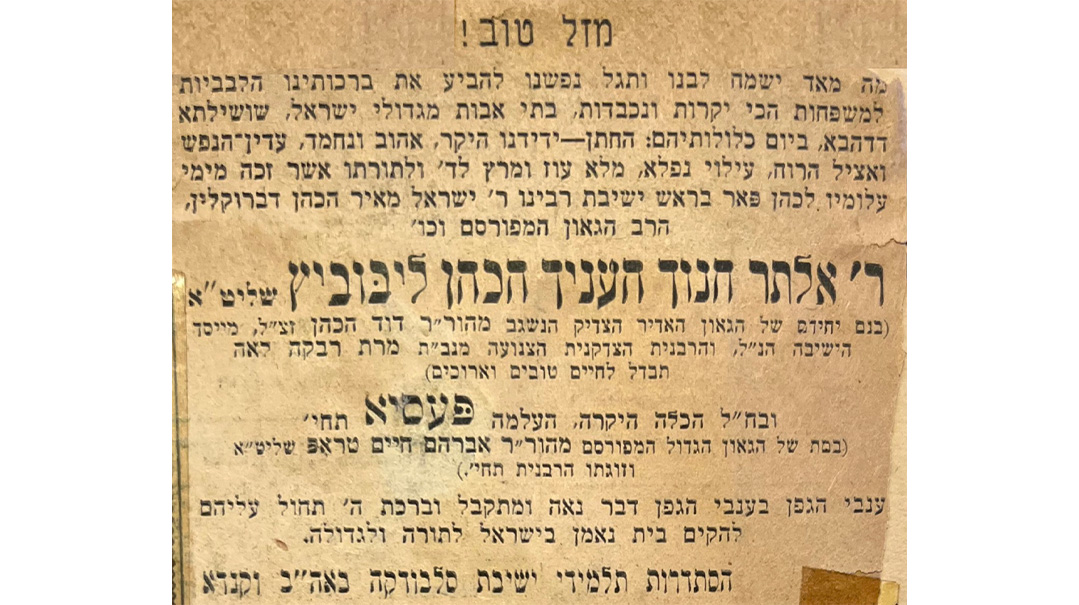
Rav Henoch Leibowitz and Pesha Trop (1950)
When Rav Henoch Leibowitz became rosh yeshivah of Yeshivah Chofetz Chaim following the untimely passing of his father, Rav Dovid, at the end of 1941, he was 23 years old and still single. Nearly a decade passed before the rosh yeshivah married Pesha Trop in 1950.
Named for her paternal grandmother Pesha Leah, who in turn was the daughter of famed Torah activist Rav Eliezer Yaakov Chavas, Rebbetzin Pesha Leibowitz was the daughter of Rav Avraham Chaim Trop, who had assumed a position in the Radin Yeshivah following the passing of his father Rav Naftali, the Radin Rosh Yeshivah.
During World War II, Pesha had accompanied her father into exile into the interior of the Soviet Union. With her marriage to Rav Henoch, a Radin connection was solidified. Her father-in-law, Rav Dovid Leibowitz, was a student of his great-uncle, the Chofetz Chaim in Radin, and had named his yeshivah for him.
Though unfortunately Rav Henoch and Rebbetzin Pesha never had children of their own, Rav Henoch served as a father to so many talmidim, while she was the “eim hayeshivah — the mother of the yeshivah.” One talmid recalled that after she learned that he had hurt his back and was bedridden for a few days, she sent a hot-water bottle to the dormitory room for pain relief and a special tray with legs, designed for eating in bed. There are many such stories.
Rav Shmuel Birnbaum said of Rebbetzin Leibowitz that she was “a shtik chesed” herself, embodying the essence of chesed. The Leibowitzes’ decades-long dedication to building the network of Yeshivas Chofetz Chaim/RSA is their everlasting legacy.
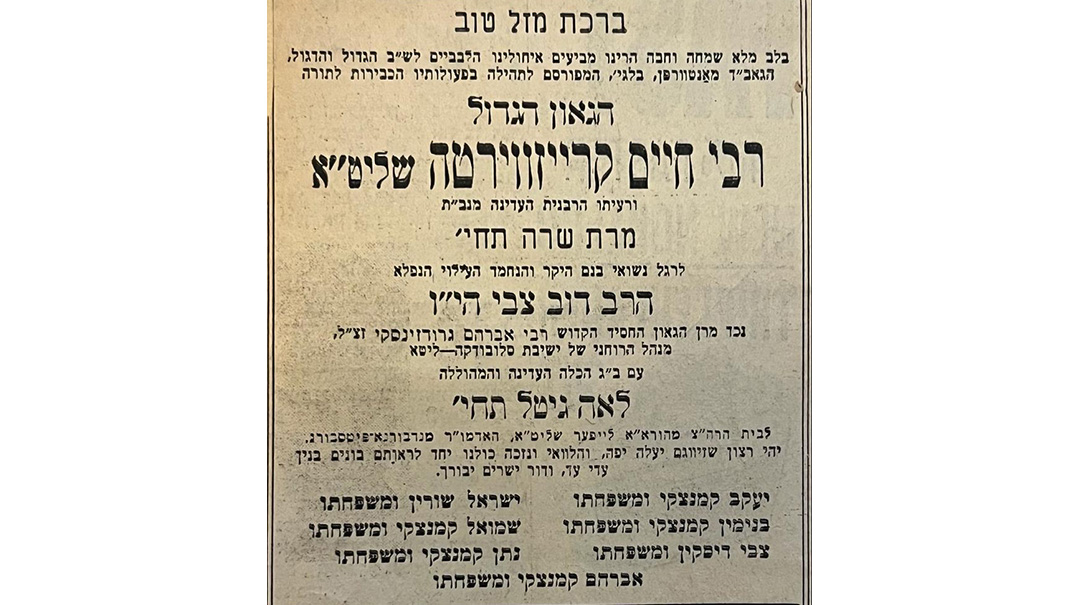
Rav Dov Tzvi Kreiswirth and Miriam Leah Gitel Leifer (1967)
Rav Dov Kreiswirth (named for his great-grandfather, Slabodka mashgiach Rav Dov Tzvi Heller) was the only son of “Krakow Illui” Rav Chaim Kreiswirth and Sarah, the daughter of martyred Slabodka mashgiach Rav Avraham Grodzinski. He was sent from Chicago to study in Israel at a young age, and grew close to the Steipler Gaon, as well as his primary rebbeim, Rav Shmuel Rozovsky, Rav Berel Soloveitchik, and Rav Moshe Shmuel Shapiro.
Rav Dov’s cousin Rav Binyomin Kamenetsky was married to the daughter of the Ostrove-Kalushin Rebbe, Rav Pinchas Eliyahu Spiegel, whose son Rav Dovid Spiegel of Cedarhurst was married to the daughter of the Pittsburgher Rebbe, Rav Avraham Abba Leifer. Rav Binyomin suggested a shidduch between Rav Dov and Miriam Leah Gitel, another daughter of the Pittsburgher Rebbe. In 1970 the Pittsburgher Rebbe relocated his court — a branch of the Nadvorna chassidic dynasty — to Ashdod.
For decades, Rav Dov and Rebbetzin Miriam Leah Gitel were bulwarks of chesed in Lakewood, where she also served as a leading mechaneches at the Bais Kaila school. He also served as rosh yeshivah in Yerushalayim at Merkaz HaTorah and later at Toras Chaim (named for his father).
In founding Toras Chaim in 2015 , Rav Dov and his rebbetzin put an emphasis on treating the talmidim with dignity and taking care of all their physical needs so they could learn b’hasmadah. This was perhaps imbued in them by Rav Chaim Kreiswirth, who, as a leading student at Chachmei Lublin, was provided a similar experience by Rav Meir Shapiro.
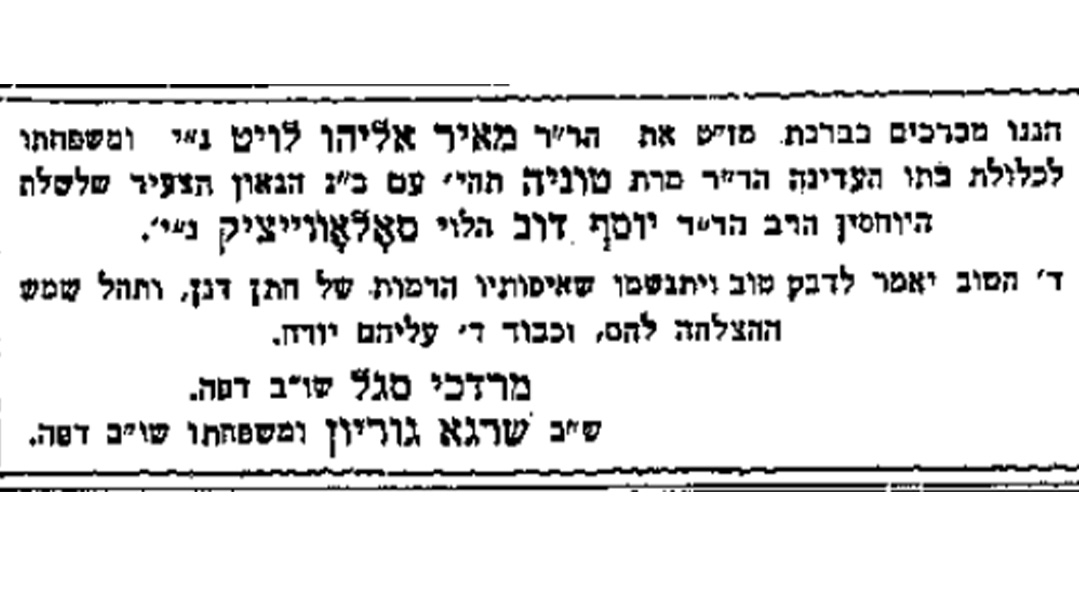
Rav Yosef Dov Soloveitchik and Tonya Lewitt (1931)
As a student at the University of Berlin in 1931, Rav Yosef Dov Soloveitchik was introduced by a fellow student to his sister, Vilna native Tonya Lewitt, who was also studying in Berlin at the time. Like the future gadol, who was a scion of a rabbinic dynasty, Tonya came from a prestigious family as well. Her mother, Gruna (née Kushilevitz), was a cousin to Rav Chaim Ozer via his father-in-law Rav Eliyahu Eliezer Grodnensky, thus connecting her to Rav Yisrael Salanter (who was Rav Grodnensky’s father-in-law).
The joy of the unification of two great Torah families of the time was dimmed somewhat by the fact that Rav Soloveitchik’s parents, Rav Moshe and Rebbetzin Pesha, missed the wedding. They had just moved to America, where Rav Moshe had become the rosh yeshivah at RIETS. Rav Soloveitchik later recalled meeting the Chazon Ish in Vilna during the months leading up to the wedding, something he relished for life.
Soon after their chasunah, the new couple moved to America, and from the very start, Rebbetzin Tonya was Rav Soloveitchik’s anchor. It was only with her encouragement that he agreed to take on the dual positions of rav in Boston and rosh yeshivah at RIETS. She stood at the forefront of chesed in the Boston Jewish community, especially as co-founder and informal director of the Maimonides School that they founded together in 1937. As years passed and Rav Soloveitchik became more occupied with other responsibilities, it was Rebbetzin Tonya who kept the school thriving.
His dedication in A Lonely Man of Faith reads: “To Tonya, A woman of great courage, sublime dignity, total commitment and uncompromising truthfulness.” Rav Soloveitchik would say (in true Brisker tradition) that he did not need to visit his father’s grave, because his father, grandfather, and the Rambam were with him at all times. Yet after his wife’s 1967 death, he visited her grave every Friday, and openly expressed his loneliness, perhaps most poignantly in a 1980 speech in which he stated, “The longing for one who has died and is gone forever is worse than death.”
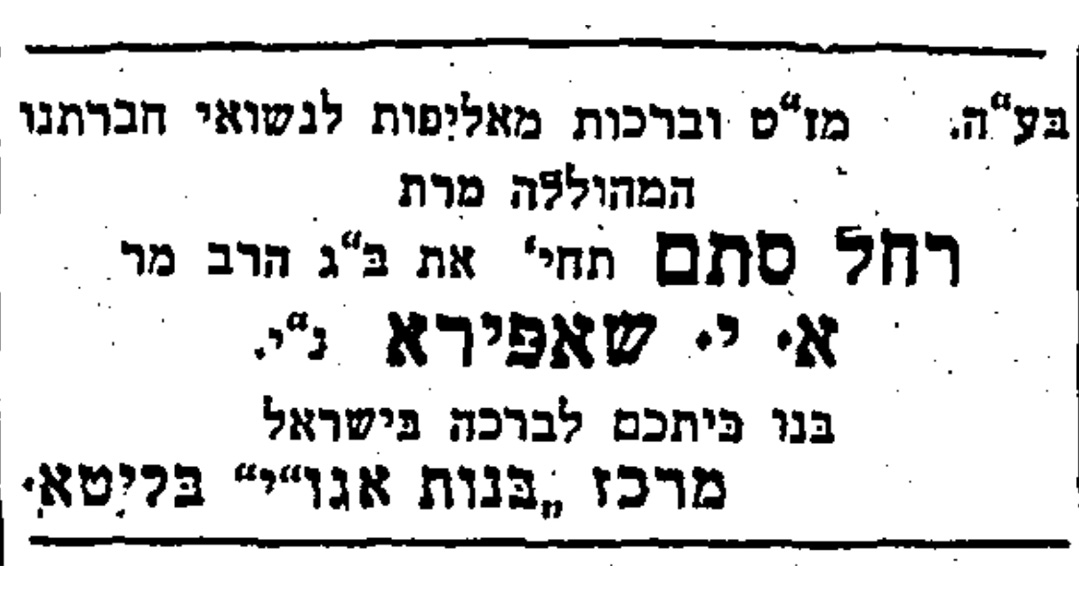
Rav Aharon Yeshaya Shapiro and Rochel Dina Stamm (1937)
In 1926 Rav Shimon Shkop asked Rav Yerucham Levovitz to send him a bochur to assist with writing his sefer Shaarei Yosher. Rav Yerucham “lent” him Aharon Yeshaya Shapiro, a star Mir talmid raised in a family of Stoliner chassidim in Pinsk, proficient in the skill of writing, with a script described as “k’yad Hashem.”
It was no surprise that young Aharon Yeshaya merited a shidduch with Rochel Dina, the daughter of Rav Yisrael Zev Stamm. The Stamms’ home was adjacent to the Kelm Talmud Torah, and Rochel Dina’s middos reflected such an upbringing. Rav Elchonon Wasserman would stay with the Stamms when he visited Kelm, and young Rochel Dina once mended his torn jacket.
The wedding took place on Tu B’Av 1937 in Riga, Latvia. Only her mother Doba Rivka arrived from Kelm for the wedding, as her father was already in the United States. The young couple settled in Riga until the war’s outbreak, when they escaped across the Soviet Union to Japan.
Rav Aharon Yeshaya was known to be a wonderful baal tefillah. The niggunim of pre-World War II Karlin were ingrained in him. After the war, not many chassidim survived, and the precious legacy of these niggunim was preserved by Rav Aharon Yeshaya, who rescued many of them from the cusp of oblivion in 1959 by recording them.
Upon arriving in the United States, Rav Aharon Yeshaya was hired as a maggid shiur in Torah Vodaath, a calling that he carried out with dedication for 40 years, shaping hundreds of lifelong talmidim. He also delivered shiurim in the shul of his father-in-law, Rav Stamm, on the Upper West Side. His daughter Shoshana married Rav Hershel Schachter, a prime student of Rav Yosef Dov Soloveitchik who now leads Yeshivas Rabbeinu Yitzchok Elchonon, while his grandson and namesake, Rabbi Aharon Yeshaya (Shai) Schachter is a rising star in the rabbinic world.
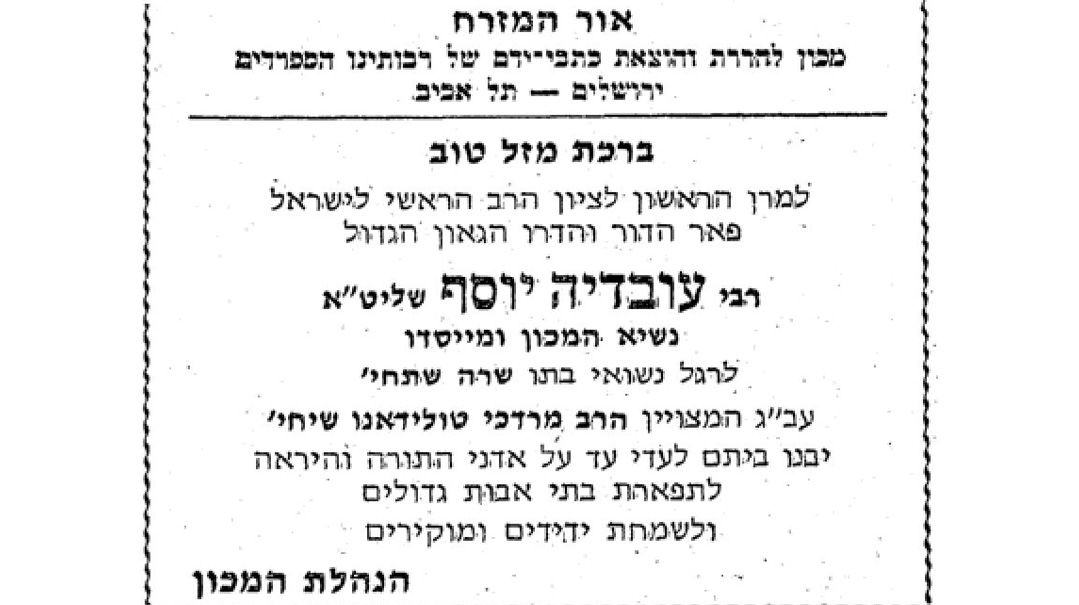
Rav Mordechai Toledano and Sarah Yosef (1977)
By 1977, Rav Ovadiah Yosef was several years into his tenure as chief rabbi of Israel and universally acknowledged as one of the leaders of the Sephardic Torah community. The various branches of the prestigious Toledano rabbinic family had by this time immigrated from Meknes, Morocco, and were firmly ensconced in the Israel rabbinic establishment as well. A scion of the family, Rav Mordechai Toledano, arrived from Meknes as a young child and studied in the Shearit Yosef Yeshivah of his cousin Rav Nissim Toledano, and in Ateres Yisrael of Rav Boruch Mordechai Ezrachi. It was only natural young Rav Mordechai would be suggested as a shidduch for Rav Ovadiah’s daughter Sarah.
Following the wedding in the famed Rabban Yochanan ben Zakai Synagogue in the Old City of Yerushalayim, Rav Toledano eventually presided over the Yabia Omer institutions at the behest of his father-in-law, and also served on the batei din in Haifa, Tel Aviv, and Yerushalayim. Rebbetzin Sarah is an artist and a kiruv activist with many leading outreach organizations in Israel.
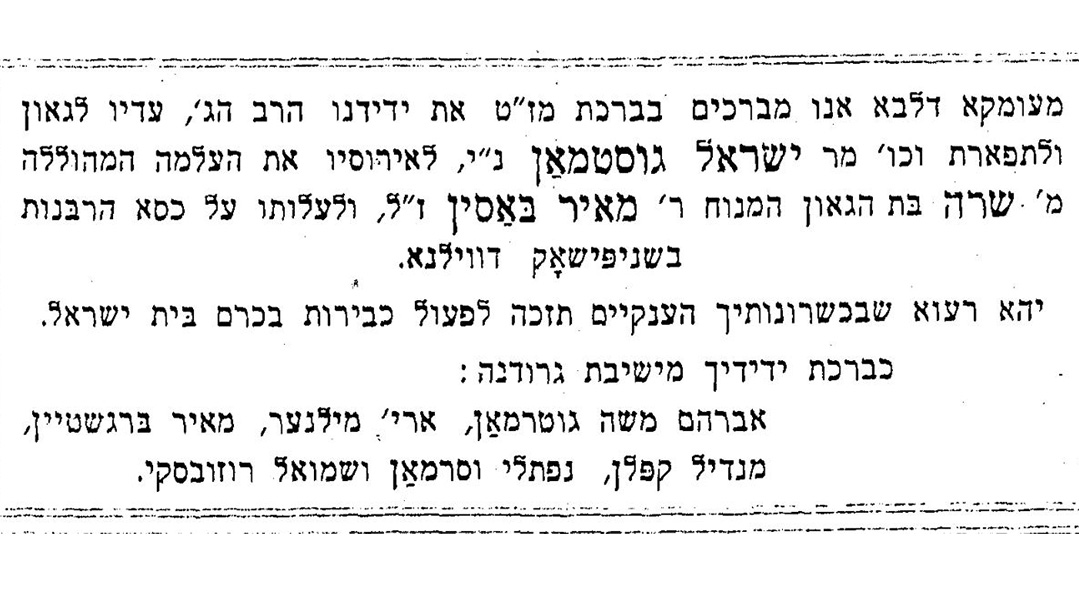
Rav Yisrael Zev Gustman and Sarah Bassin (1932)
One of the shining lights of the interwar yeshivah world and a prime student in the Grodno yeshivah, Yisrael Zev Gustman was the apple of Rav Shimon Shkop’s eye. A shidduch was suggested for him with Sarah Bassin, who belonged to one of Vilna’s most prominent families. A direct descendant of the Be’er Hagolah on her mother’s side, her father Rav Meir Bassin was a dayan on the Vilna Beis Din and a close confidant of Rav Chaim Ozer Grodzenski.
Upon hearing about the shidduch, Rav Chaim Ozer insisted on meeting the young scholar and talking to him in learning for nearly four hours. Rav Chaim Ozer was so impressed that he invited him to return the following day, and questioned him in learning with the entire Vilna Beis Din present. Rav Yisrael Zev answered a question Rav Chaim Ozer himself had difficulty explaining, and when one of the dayanim attempted to refute his ingenious answer, Rav Chaim Ozer demanded, “What’s wrong? Di kallah iz tzu shein? [The bride is too beautiful?]”
Shortly before the wedding, Rav Meir Bassin suddenly passed away. Rav Chaim Ozer took care of the arrangements, and Rav Shlomo Heiman and his wife acted in place of the kallah’s parents. Shortly after the wedding, Rav Chaim Ozer appointed Rav Yisrael Zev to his late father-in-law’s seat on the Vilna Beis Din. He later delivered shiurim in the Ramailes Yeshivah, following Rav Shlomo Heiman’s departure for Torah Vodaath in 1935.
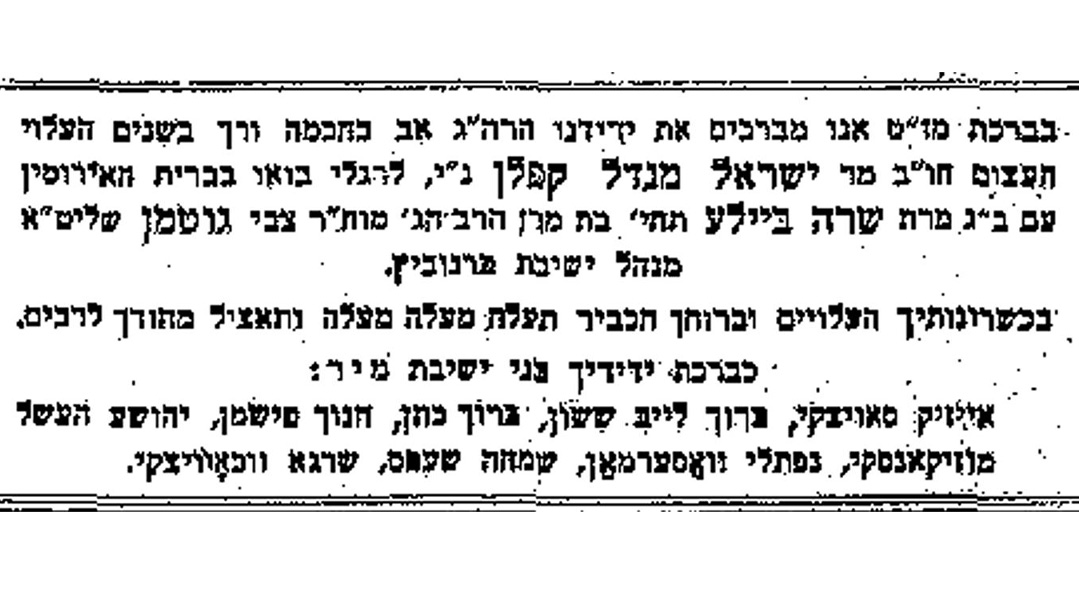
Rav Mendel Kaplan and Sarah Baila Gutman (1933)
When Rav Zvi Hirsh Gutman, the menahel of the Baranovich Yeshivah, sought a suitable shidduch for his daughter Sarah Baila, he asked the rosh yeshivah, Rav Elchonon Wasserman, about several bochurim, including the latter’s own son Naftoli. Rav Elchonon chose 20-year old Yisrael Mendel Kaplan, a talmid and Baranovich native who had by then moved on to the Mir.
Their chuppah took place in 1935 in the backyard of Rav Yisrael Yaakov Lubchansky, mashgiach of the yeshivah, in knee-deep snow. Rav Elchonon’s boundless affection for his talmid was on full display as he danced with all his might, in the same unique way he danced on Simchas Torah. The Kaplans lived for some time in an apartment adjoining Rav Elchonon’s, cementing the close bond between rebbi and talmid. When Rav Elchonon traveled overseas, Reb Mendel would deliver his rebbi’s shiur in his stead.
Reb Mendel, Sarah Baila, and their children eventually rejoined the Mir on its legendary escape to Shanghai. After the war, Reb Mendel transmitted the legacy of his great rebbeim to generations of talmidim in Chicago, New York, and Philadelphia, until his petirah in 1985. Rebbetzin Sarah Baila was the quintessential eishes chaver, and a tzadeikes and giant of chesed in her own right, a loving bubby to her grandchildren and great-grandchildren, and an indefatigable fundraiser for the needy of Eretz Yisrael. She passed away in 2008.
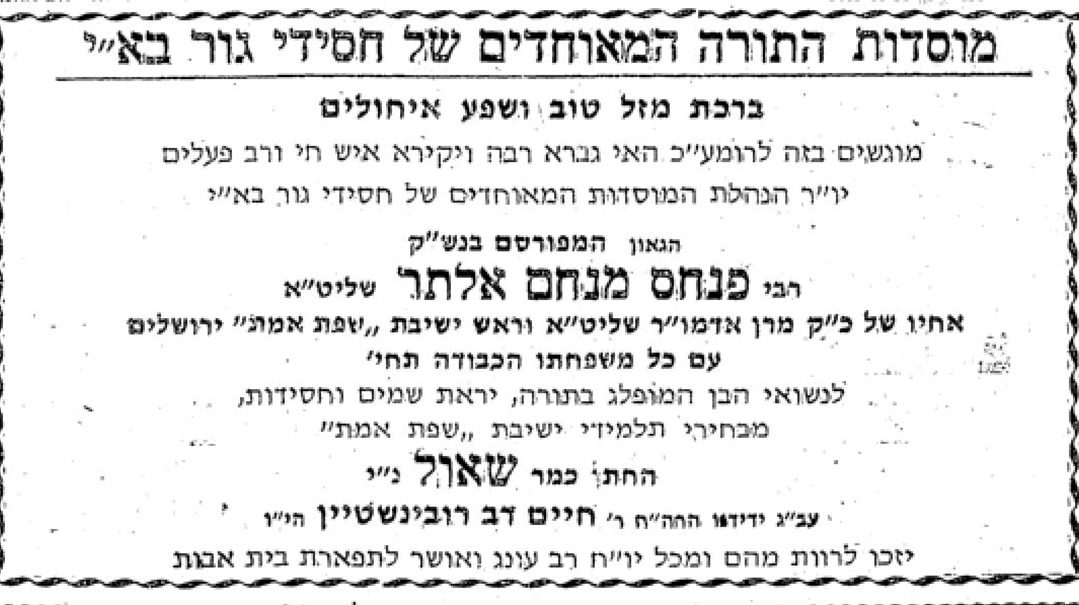
Rav Shaul Alter and Naomi Rubinstein (1977)
The Imrei Emes of Gur, Rav Avraham Mordechai Alter, following the passing of his first wife, married his niece Faiga Mintsha, daughter of his esteemed brother-in-law Rav Yaakov Meir Biderman, one of the leading rabbis of Warsaw who perished in the Ghetto.
The Imrei Emes’s only child from this marriage was Rav Pinchas Menachem Alter, the Pnei Menachem. In 1946, the Pnei Menachem married his cousin Tziporah, granddaughter of the legendary prewar Gur leader Rav Moshe Betzalel Alter, who had been killed by the Nazis in Treblinka. In 1957, their son Shaul was born. At 20 years old, he’d marry outside the family into a prominent Gerrer family from Haifa — Naomi, daughter of Rav Chaim Ber Rubinstein. Rav Chaim Ber owned a seforim store in Haifa, was a rebbi in a local cheder, and was a mainstay of the Gerrer community in largely secular Haifa for decades.
Rav Shaul’s uncle, the Beis Yisrael of Gur, was still alive when the engagement was announced, but passed away prior to the wedding, at which his other uncle, the Lev Simcha, assumed the mantle of leadership over the Gerrer chassidus. Rav Shaul settled in Haifa, where he served as a maggid shiur in the Ohr Simcha Yeshivah, one of the leading Gerrer yeshivos in the country.
(Originally featured in Mishpacha, Issue 907)
Oops! We could not locate your form.





